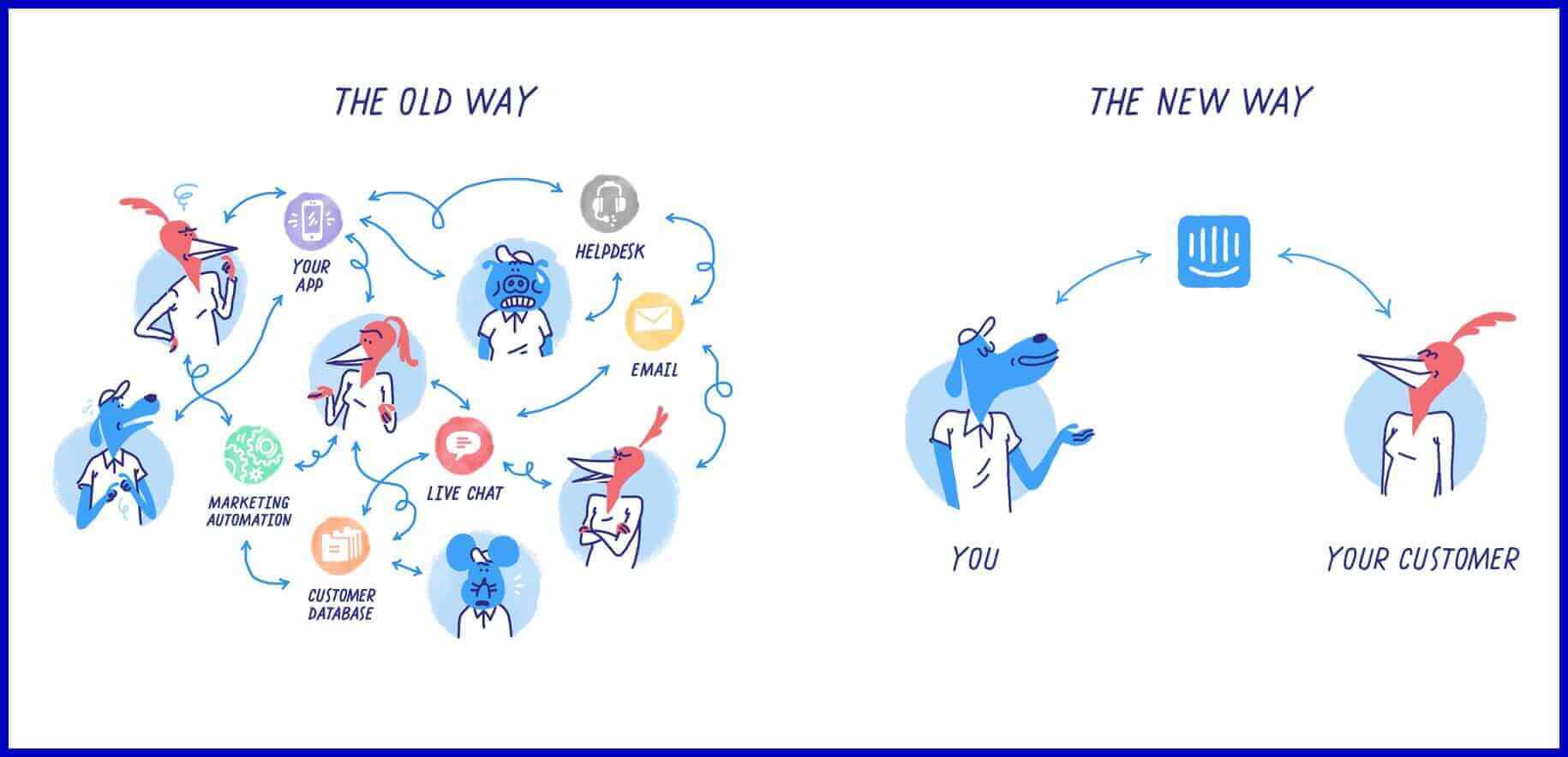
Intercom turns 10: Highlights from our first decade
Main illustration: Jason Yim
Table of contents:
- 1. Our first pitch deck
- 2. Inventing the Business Messenger
- 3. Writing our story
- 4. Celebrating our teams
- 5. Right message, right time, right place
- 6. Bringing our brand on the road
- 7. Raising money to fuel our growth
- 8. Automation for the people
- 9. Changing the support conversation
- 10. A new era under a new CEO
- The decade ahead
This month marks 10 years since Eoghan McCabe, Des Traynor, David Barrett, and Ciaran Lee launched Intercom and began their mission to make internet business personal.
We have achieved a great deal in the past decade – we have built a lot of great product, hired hundreds of wonderful people, and helped thousands of amazing companies form lasting relationships with their own customers.
It’s in our nature to look forward, to focus on shipping, to keep innovating and providing value. It’s the journey ahead that excites us, but today, we reflect on the journey from there to here – the major moments and milestones that have defined us as a company and as a group of people. Here, we look at 10 highlights from 10 years of Intercom, from our first pitch deck to the evolution of our product, our story, and our team.
1. Our first pitch deck
Intercom began when our four co-founders were inspired to solve the problem online businesses faced trying to build relationships with their customers. Reflecting on the close connection their favorite barista was making with his regulars, they considered what is involved in forging strong relationships between businesses and customers.
“Sensing an opportunity, they switched their focus and Intercom was born”
It was a problem they were facing themselves as they struggled to communicate with the users of their existing app, Exceptional. Sensing an opportunity, they switched their focus and Intercom was born – the app was released in private beta in July and the company was founded in August, 2011.

David Barrett, Des Traynor, Eoghan McCabe, and Ciaran Lee on the day of Intercom’s founding
Nothing captures the early ambition and vision of the co-founders as succinctly as their first pitch deck from late 2011, a snappy eight slides that outlined the scale of the opportunity to forge new ways of connecting with customers. They were seeking an initial $600,000 in funding.
“We started to ask ourselves, ‘Was that kind of human connection even possible for online businesses?’ We came to the belief that, yes, it was, but that the tools that were available at the time were the things holding people back. We came to see that there was great, great room for improvement and that there was an opportunity to create tools that could much better support human connection.”
Eoghan describes the original vision behind Intercom.
2. Inventing, and reinventing, the Business Messenger
It’s hard to recall now, but before Intercom released the world’s first in-app messenger in 2011, the chat bubble was not a ubiquitous feature of apps or websites. Our Business Messenger revolutionised that space, creating a convenient, accessible channel for customers to begin conversations with companies.
“While the Messenger started out as a way to chat, it has grown to become something much more powerful – a versatile, convenient way to sustain relationships with customers”
The Intercom Messenger has continued to evolve, expanding its utility with every iteration. In 2016, we released a new version which featured deep customization, cross-platform compatibility, new message formats, and playful emoji support.
In 2018, we released a completely reimagined Business Messenger, a full-fledged “front desk for your website or app,” complete with a homepage and a library of embeddable apps. While the Messenger started out as a way to chat, it has grown to become something much more powerful – a versatile, convenient way to sustain relationships with customers.
“In the blink of an eye relative to human history, messengers have left everything in their wake, from phone calls to email to SMS … In the foreseeable future, every internet business will use a messenger on their website and in their app as the primary way they interact with existing and prospective customers.”
Paul Adams, SVP of Product, summarizes the power of messaging.
3. Writing our story
Writing has been a core part of Intercom’s DNA since its inception – Des wrote 93 of the first 100 blog posts here on Inside Intercom. For a certain audience, Intercom was arguably more famous for its content than its product.
Beginning in 2015, we expanded beyond regular blog posts to publish books containing our insights and opinions. This acclaimed series included titles focusing on product management, customer engagement, and Jobs-to-be-Done.
The deluxe hardback copy of Intercom on Starting Up epitomized the approach – a beautiful item in its own right that became a coveted collectible among fans and influenced the industry.

”Writing one proverbial bestseller isn’t easy, but it’s not uncommon. Writing two, three, or ten is hard. There aren’t any tricks here: focus on writing good content, present it tastefully, and engage with your readers afterwards. Ultimately, that’s what it takes for your content to inspire and resonate with people time and time again.”
John Collins, former Director of Content, describes the ethos behind our content.
4. Celebrating our teams
Building a great company requires a lot of ingredients, but ultimately it involves hiring great people and creating an environment where they’re able to do great work.
We famously mark our work anniversaries with annual Intercomics and Intercards – a beloved way of celebrating each other and our work. These comics adorn the walls of our offices around the world, connecting us to one another no matter where we are. And while we are currently preparing for a return to our offices, that sense of connection has felt more important than ever during the pandemic.

“As you cross each year as an employee in Intercom, we make you a custom comic. We call them Intercomics. We do this to celebrate and acknowledge people’s massive contributions and to reflect the ways in which we’ve all gotten to know the person well. We hang them on the walls of our offices. When I walk past these comics, I remind myself there’s something that lasts longer than products or blog posts, or a tour talk, and something that matters more than dope metrics and MRR. Intercom would be nothing without these people.”
Des on the importance of recognizing our people.
5. Right message, right time, right place
Conversations are two-way streets, back-and-forth exchanges between two parties. From the earliest days of Intercom, we were determined to make it easier for companies to begin conversations with their customers, and prospective customers, with personalized messages.
“Throughout the years, we have always emphasized our core philosophy around customer messaging – send the right message, to the right person, at the right time, in the right place”
From our groundbreaking automated emails feature in April 2012, which allowed companies to carefully target their email campaigns, to the sophisticated outbound messaging automation of Smart Campaigns, and just last year, the powerful visual campaign builder called Series, we have been helping companies engage their customers at every stage of the relationship.
Over the years, we have always emphasized our core philosophy around customer messaging – send the right message, to the right person, at the right time, in the right place. This mantra holds true whether it’s an onboarding flow, a nurture campaign, or any other type of customer message.

“Regardless of the tool you use for automated mails, take care to message the right users at the right time, in a personal manner. It’s the only way to show your customers you care.”
Des singles out the key to successful customer engagement.
6. Bringing our brand on the road
A company is more than the product it makes or the people who work there, it’s also the brand that people connect with. But a brand isn’t just your logo – it’s the connection you establish with your customers and prospective customers.
To make that connection in the real world, we began hosting a series of events in 2015, effectively a live version of the Inside Intercom blog.

In 2016 and 2017, we took these talks on the road with the incredibly ambitious Inside Intercom World Tours, filling venues in more than a dozen cities with a stunning audiovisual experience. The 2017 tour ran for six months, visited 10 cities with 12 speakers, and had around 6,000 attendees in total.
“You can’t tell until you start to run your own events and you’re in a room with a couple hundred people that care about what you’re saying, but you’re having an open conversation and that’s massively valuable and actually pretty priceless. It started to become pretty clear … that this was something special.”
Megan Sheridan, former Experience Brand Manager, captures the unique power of live events.
7. Raising money to fuel our growth
A series of funding rounds over the years ended up yielding $241 million in investments from the likes of Social Capital, Bessemer, ICONIQ, and, in 2018, a Series D round led by Kleiner Perkins and GV, which valued Intercom at $1.275 billion. We even found different ways of making these announcements fun and interesting, while sharing the major lessons we learned along the way.
“It’s fair to say that fundraising is a pseudo-achievement. It doesn’t in itself create value. That comes from what you spend the money on. Yet it’s worth celebrating because of what you really have achieved to be able to convince smart people to back you.”
Eoghan articulates our perspective on fundraising.
8. Automation for the people
We have always been very opinionated about what bots can and can’t do, where humans are required, and what the balance between the two should look like in practice. But delivering personal, satisfactory customer experiences at internet scale requires thoughtful, well-considered automation, complementing human support.

Overcoming the general mistrust of chatbots requires excellently designed chatbot experiences, and to that end we delivered a range of automated solutions under the Operator banner, beginning in 2017. We followed with Custom Bots a year later, which allow you to create completely customizable chatbots on your website in minutes. Finally, we unveiled Resolution Bot, an incredibly powerful bot that enables automatic responses to common customer queries.
In the process, we turned ourselves from chatbot skeptics to believers – at internet scale, automation plays a key part in facilitating relationships between businesses and customers.
“Bots have the potential to deliver radical efficiencies to sales and marketing and support teams. You could imagine how sales teams could use bots to have always on, always available, always consistent, infinitely easy to train reps available to talk to prospects. Or marketing teams could have tailored, one-on-one, white glove service bots that could hold the hand of users as they started to use your products. Or support teams could have bots as the front line of defense to triage inbound inquiries, get more information from customers, or even solve problems.”
Eoghan on the potential for automation to transform customer relationships.
9. Changing the support conversation
The transition to online business has dramatically expanded the number of customers any given business deals with – and also increased the complexity of customer issues to be resolved.
But customer expectations have dramatically changed in the past decade. They want fast responses, and they don’t want to be treated as impersonal tickets.
“Customer expectations have dramatically changed in the last decade, and customers are switching to forward thinking businesses who are investing in consumer-level customer experiences”
This has clearly become one of the most urgent pain points for online businesses, and we have focused a lot of time and attention on resolving that. Our range of products are designed to work together to provide the sort of fast, convenient, personalized support that people expect – our Messenger, bots, knowledge base, and customer data platform all work seamlessly to satisfy customers’ expectations when they encounter a problem that needs solving.
To illustrate how powerful these features are together, we created the concept of the Conversational Support Funnel, consisting of Proactive Support, Self-serve Support, and finally Human Support to handle the most complex questions.
“Customer expectations have dramatically changed in the last decade, and customers are switching to forward thinking businesses who are investing in consumer-level customer experiences, leaving old, inferior customer support software behind. They are switching because they know they can get fast, flexible, modern, personal support.”
Paul on the importance of modern customer support.
10. A new era under a new CEO
In July 2020, after nearly 9 years as CEO, Eoghan moved to the role of Chairman, and Karen Peacock assumed the position of our Chief Executive Officer.
“Our future is bright and it is about to get even more exciting. We will build it together”
Karen joined as COO in 2017, after nearly 14 years of experience at Intuit, and she has already overseen an acceleration of our growth, despite the economic volatility created by the pandemic over the past 16 months.

“We have a big product vision, and we are audacious. Our Messenger and platform are changing the way businesses build relationships with their customers… Thank you all so much – we would not be here without the brilliant work of each of you. Our future is bright and it is about to get even more exciting. We will build it together.”
Karen sets out her ambitious vision for Intercom’s future.
The decade ahead
If the past 10 years has taught us anything, it’s that we can dream bigger than we would have ever thought possible. As the saying goes, people often overestimate what can be achieved in a year, but underestimate what can be achieved in a decade.
After 10 years of this adventure, we now know what we can achieve with hard work, perseverance, and optimism. The opportunity before us is immense. See you all back here in 2031 to reflect on Intercom’s next decade.






